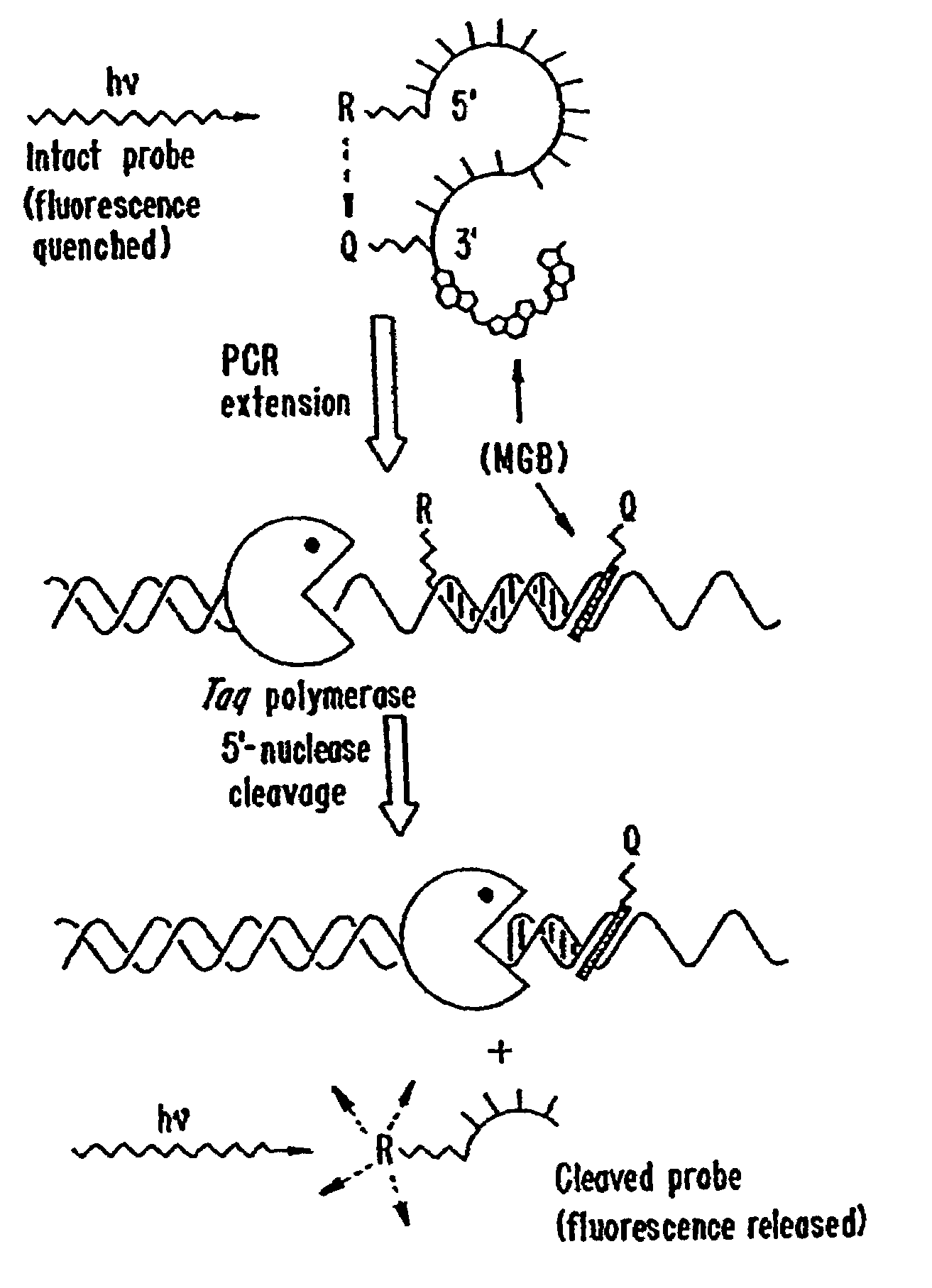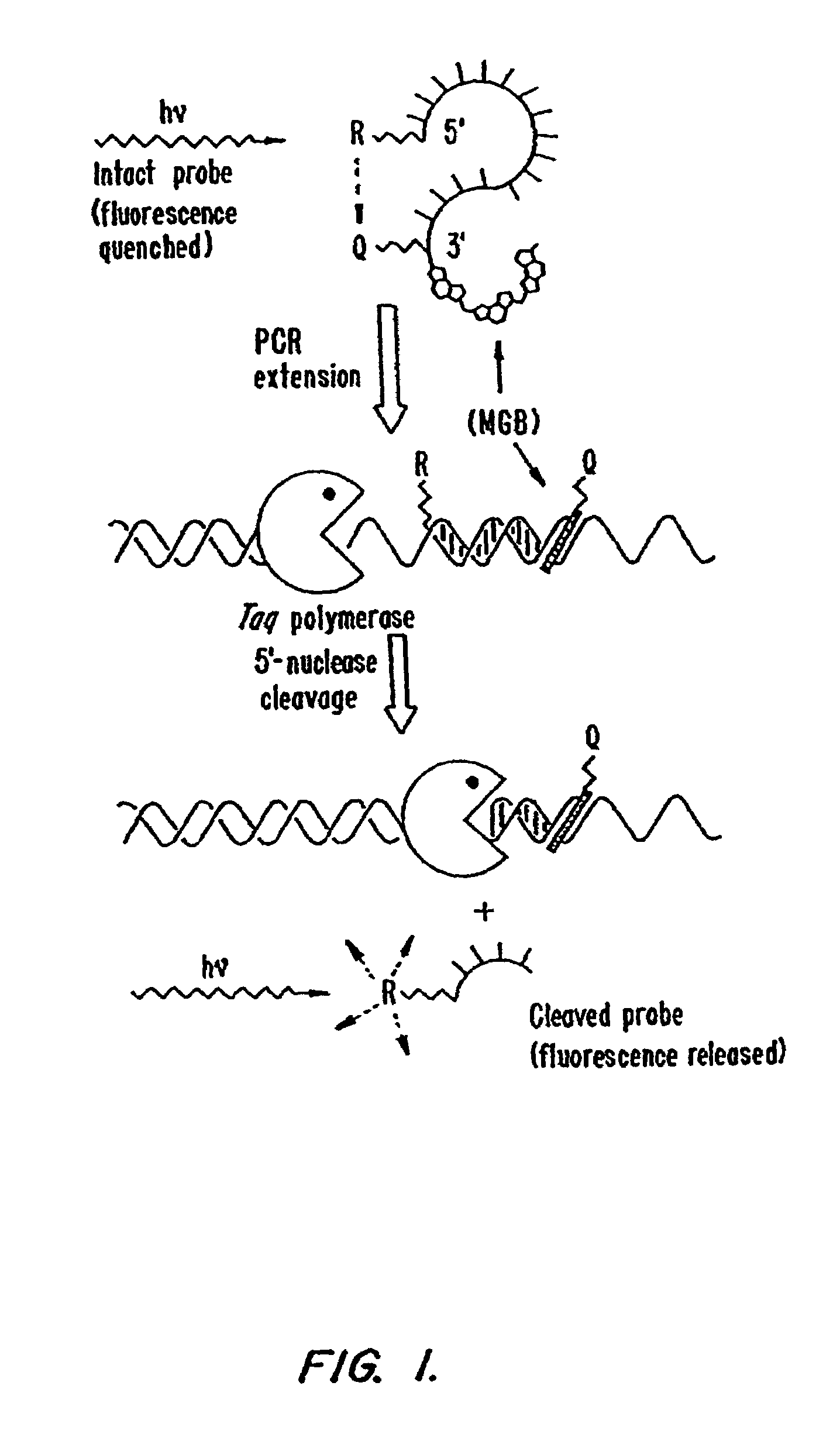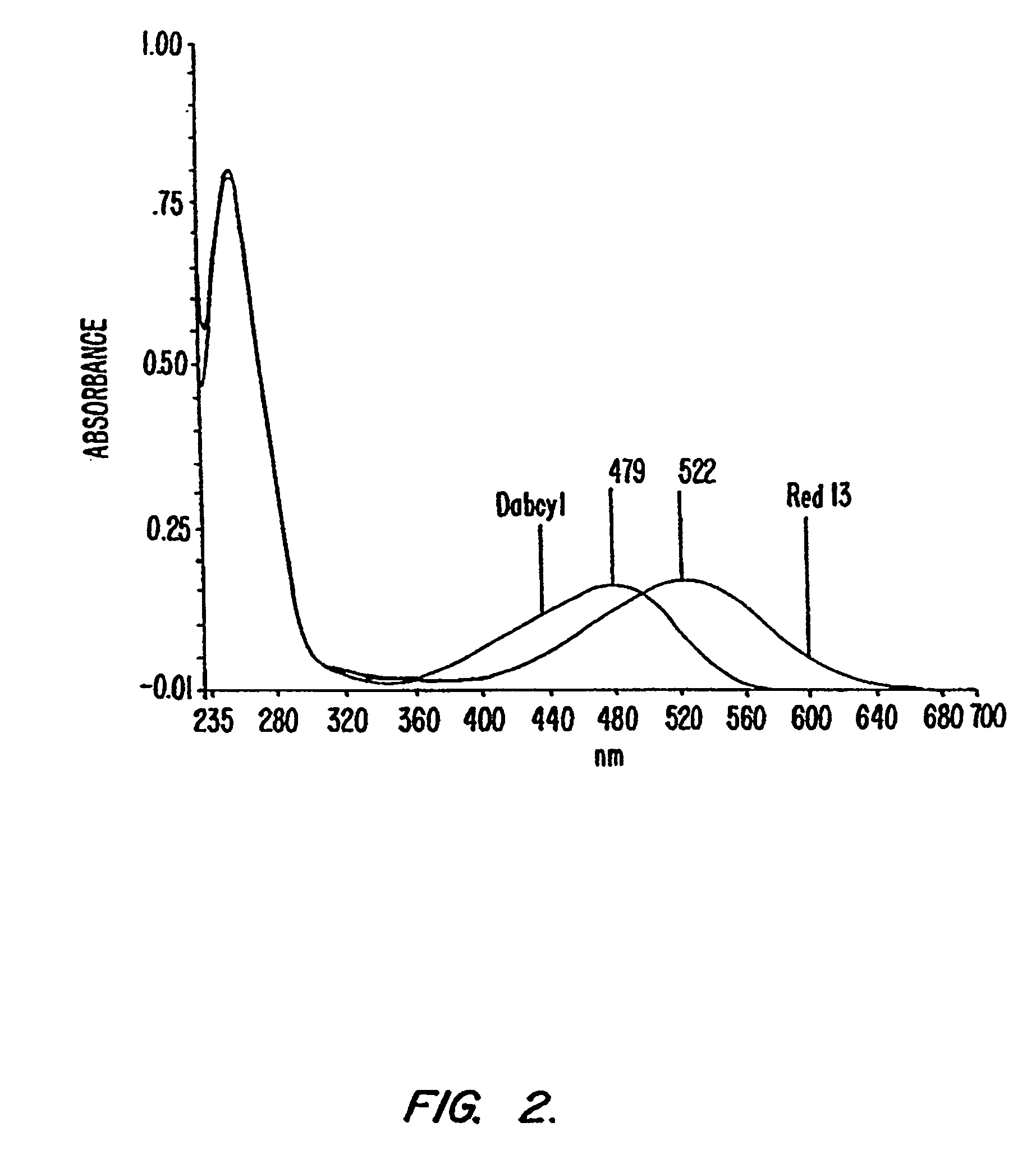Fluorescent quenching detection reagents and methods
a technology of fluorescent quenching and detection reagents, applied in the field of oligonucleotidequenchingfluorescentdye conjugates, can solve the problems of few commercially available phosphoramidite reagents, pcr-based diagnostic assays have not been used initially routinely, and the donor fluorescence is not quenched, so as to improve the signal to noise ratio, improve the uv spectral overlap, and improve the effect of uv
- Summary
- Abstract
- Description
- Claims
- Application Information
AI Technical Summary
Benefits of technology
Problems solved by technology
Method used
Image
Examples
example 1
[0225]This example illustrates the preparation of a quencher phosphoramidite reagent according the methods outlined in Reaction Scheme 1. The product is 2-({4-[(2-Chloro-4-nitrophenyl)diazenyl]phenyl}ethylamino)ethyl (2S,4R)-2-{[bis(4-methoxyphenyl)phenylmethoxy]methyl}-4-{[bis(methylethyl)amino](2-cyano-ethoxy)phosphinooxy}pyrrolidinecarboxylate (5a).
[0226]
2-({4-[(2-Chloro-4-nitrophenyl)diazenyl]phenyl}ethylamino)ethyl(5S,3R)-3-hydroxy-5-(hydroxymethyl)pyrrolidinecarboxylate (3a)
[0227]A solution of 2-[4-(2-chloro-4-nitrophenylazo)-N-ethylphenylamino]ethanol (Disperse Red 13, Aldrich Chemical Co., 9.0 g, 25.80 mmol) and 4-nitrophenyl chloroformate (Aldrich Chemical Co., 9.4 g, 46.61 mmol) in 90 ml of anhydrous pyridine was stirred at 70° C. for 40 min, affording intermediate 2a. Ethanol (5.0 ml) was added to the reaction solution followed by trans-hydroxyprolinol (Reed et al., Bioorg. Chem. 2:217-225 (1991) (42 ml of a 0.5 M solution in ethanol) and triethylamine (3.2 ml). The resul...
example 2
[0230]This example illustrates the preparation of a solid support (CPG) bound quencher-linker conjugate (12 in Reaction Scheme 3) that can be used for the preparation of additional reagents described herein.
[0231]
Synthesis of pentafluorophenyl ester (11) and RED 13-pyrrolidine-DMTr-CPG (12) Reactions Scheme 3
[0232]The pentafluorophenyl ester (11) is synthesized by the same method used for the synthesis of Compound 22 as described in Example 4 and Reaction Scheme 5.
RED 13-ppyrrolidine-DMTr-CPG (12)
[0233]10 g of LCM-CPG was combined with 5 ml of a 0.3 M solution of 11 in DMF and agitated gently overnight, when it was filtered and washed with 2×100 mL of DMF, 2×100 mL of acetonitrile, and 2×100 mL of ether. Traces of ether were removed in vacuo (oil pump). Unreacted amino groups were acetylated by treating the CPG with 40 mL of dry pyridine and 5 mL of acetic anhydride. After swirling for 1.5 h, the CPG was filtered and washed with 2×100 mL of DMF, 2×100 mL of acetonitrile, and 2×100 m...
example 3
[0234]This example illustrates the preparation of MGB precursors as described in Reaction Scheme 4 and further developed in Reaction Schemes 5-7. Specifically, 2-(4-nitrophenyl)ethyl 3-(pyrrolo[4,5-e]indolin-7-ylcarbonyl)pyrrolo[4,5-e]indoline-7-carboxylate (17, Reaction Scheme 4) is described.
2-(4-Nitrophenyl)ethyl 3-[(tert-butyl)oxycarbonyl]pyrrolo[4,5-e]indoline-7-carboxylate (14)
[0235]Ten grams (33.1 mmol) of 3-[(tert-butyl)oxycarbonyl]pyrrolo[3,2-e]indoline-7-carboxylic acid (Boger et al., J. Org. Chem. 52:1521 (1987)), well dried, are placed into an argon filled flask, and 84 mL of THF and 10.4 mL (66.2 mmol) of diethyl azodicarboxylate (DEAD) are added. A dropping funnel is placed atop the flask (flushed with argon) and a water bath (to cool the flask) is placed under it. A solution of 17.3 g (66 mmol) of triphenylphosphine and 6.64 g (39.7 mmol) of 2-(p-nitrophenyl)ethanol in 160 mL of ethyl ether is made. This solution is added to the dropping funnel, and then to the reacti...
PUM
| Property | Measurement | Unit |
|---|---|---|
| emission wavelength | aaaaa | aaaaa |
| emission wavelength | aaaaa | aaaaa |
| wavelength | aaaaa | aaaaa |
Abstract
Description
Claims
Application Information
 Login to View More
Login to View More - R&D
- Intellectual Property
- Life Sciences
- Materials
- Tech Scout
- Unparalleled Data Quality
- Higher Quality Content
- 60% Fewer Hallucinations
Browse by: Latest US Patents, China's latest patents, Technical Efficacy Thesaurus, Application Domain, Technology Topic, Popular Technical Reports.
© 2025 PatSnap. All rights reserved.Legal|Privacy policy|Modern Slavery Act Transparency Statement|Sitemap|About US| Contact US: help@patsnap.com



